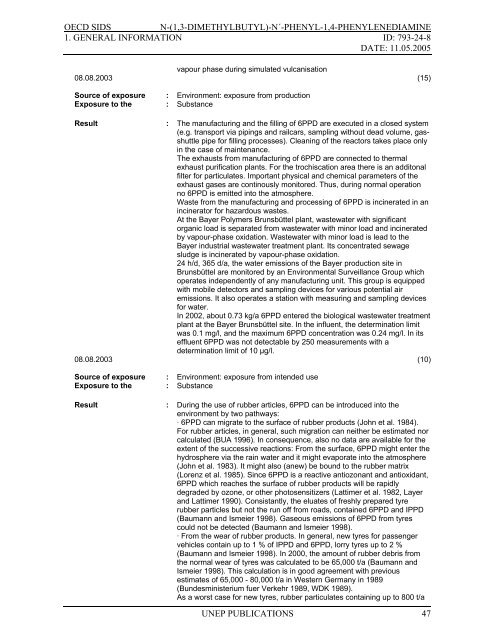N-(1,3-Dimethylbutyl)-N
N-(1,3-Dimethylbutyl)-N
N-(1,3-Dimethylbutyl)-N
Create successful ePaper yourself
Turn your PDF publications into a flip-book with our unique Google optimized e-Paper software.
OECD SIDS<br />
N-(1,3-DIMETHYLBUTYL)-N´-PHENYL-1,4-PHENYLENEDIAMINE<br />
1. GENERAL INFORMATION ID: 793-24-8<br />
DATE: 11.05.2005<br />
vapour phase during simulated vulcanisation<br />
08.08.2003 (15)<br />
Source of exposure : Environment: exposure from production<br />
Exposure to the : Substance<br />
Result : The manufacturing and the filling of 6PPD are executed in a closed system<br />
(e.g. transport via pipings and railcars, sampling without dead volume, gasshuttle<br />
pipe for filling processes). Cleaning of the reactors takes place only<br />
in the case of maintenance.<br />
The exhausts from manufacturing of 6PPD are connected to thermal<br />
exhaust purification plants. For the trochiscation area there is an additonal<br />
filter for particulates. Important physical and chemical parameters of the<br />
exhaust gases are continously monitored. Thus, during normal operation<br />
no 6PPD is emitted into the atmosphere.<br />
Waste from the manufacturing and processing of 6PPD is incinerated in an<br />
incinerator for hazardous wastes.<br />
At the Bayer Polymers Brunsbüttel plant, wastewater with significant<br />
organic load is separated from wastewater with minor load and incinerated<br />
by vapour-phase oxidation. Wastewater with minor load is lead to the<br />
Bayer industrial wastewater treatment plant. Its concentrated sewage<br />
sludge is incinerated by vapour-phase oxidation.<br />
24 h/d, 365 d/a, the water emissions of the Bayer production site in<br />
Brunsbüttel are monitored by an Environmental Surveillance Group which<br />
operates independently of any manufacturing unit. This group is equipped<br />
with mobile detectors and sampling devices for various potential air<br />
emissions. It also operates a station with measuring and sampling devices<br />
for water.<br />
In 2002, about 0.73 kg/a 6PPD entered the biological wastewater treatment<br />
plant at the Bayer Brunsbüttel site. In the influent, the determination limit<br />
was 0.1 mg/l, and the maximum 6PPD concentration was 0.24 mg/l. In its<br />
effluent 6PPD was not detectable by 250 measurements with a<br />
determination limit of 10 µg/l.<br />
08.08.2003 (10)<br />
Source of exposure : Environment: exposure from intended use<br />
Exposure to the : Substance<br />
Result : During the use of rubber articles, 6PPD can be introduced into the<br />
environment by two pathways:<br />
· 6PPD can migrate to the surface of rubber products (John et al. 1984).<br />
For rubber articles, in general, such migration can neither be estimated nor<br />
calculated (BUA 1996). In consequence, also no data are available for the<br />
extent of the successive reactions: From the surface, 6PPD might enter the<br />
hydrosphere via the rain water and it might evaporate into the atmosphere<br />
(John et al. 1983). It might also (anew) be bound to the rubber matrix<br />
(Lorenz et al. 1985). Since 6PPD is a reactive antiozonant and antioxidant,<br />
6PPD which reaches the surface of rubber products will be rapidly<br />
degraded by ozone, or other photosensitizers (Lattimer et al. 1982, Layer<br />
and Lattimer 1990). Consistantly, the eluates of freshly prepared tyre<br />
rubber particles but not the run off from roads, contained 6PPD and IPPD<br />
(Baumann and Ismeier 1998). Gaseous emissions of 6PPD from tyres<br />
could not be detected (Baumann and Ismeier 1998).<br />
· From the wear of rubber products. In general, new tyres for passenger<br />
vehicles contain up to 1 % of IPPD and 6PPD, lorry tyres up to 2 %<br />
(Baumann and Ismeier 1998). In 2000, the amount of rubber debris from<br />
the normal wear of tyres was calculated to be 65,000 t/a (Baumann and<br />
Ismeier 1998). This calculation is in good agreement with previous<br />
estimates of 65,000 - 80,000 t/a in Western Germany in 1989<br />
(Bundesministerium fuer Verkehr 1989, WDK 1989).<br />
As a worst case for new tyres, rubber particulates containing up to 800 t/a<br />
UNEP PUBLICATIONS 47
















